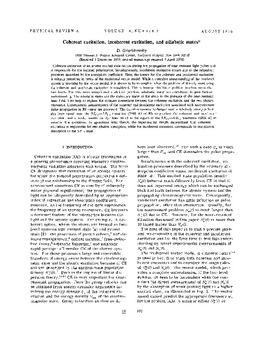| dc.contributor.author | Grischkowsky, D. | |
| dc.date.accessioned | 2015-10-16T20:48:18Z | |
| dc.date.available | 2015-10-16T20:48:18Z | |
| dc.date.issued | 1976-08 | |
| dc.identifier | okds_Grischkowsky_PRA_1976-08 | |
| dc.identifier.citation | Grischkowsky, D. (1976). Coherent excitation, incoherent excitation, and adiabatic states. Physical Review A, 14(2), 802-812. https://doi.org/10.1103/PhysRevA.14.802 | |
| dc.identifier.uri | https://hdl.handle.net/11244/19895 | |
| dc.description.abstract | Coherent excitation of an atomic excited state occurs during the propagation of near-resonant light pulses and is responsible for the induced polarization. Simultaneously, incoherent excitation occurs due to the relaxation processes described by the absorption coefficient. Here, the theory for the coherent and incoherent excitation is initially presented in terms of the traditional vector model. While a complete understanding of the two-level system is provided by the vector model, it is shown to be incomplete when the problem of directly monitoring the coherent and incoherent excitation is considered. This is because this latter problem involves more than two levels. For this more complicated multilevel problem, adiabatic states are introduced to gain further understanding. The adiabatic states are the stationary states of the atom in the presence of the near-resonant laser field; they help to explain the intimate connection between the coherent excitation and the two-photon resonance. Experimental measurements of the coherent and incoherent excitation associated with near-resonant pulse propagation in Rb vapor are presented. The double-resonance technique used a relatively strong pulsed dye laser tuned near the 5S1/2 <-> 5P1/2 transition (7948 A) of Rb to produce the coherent and incoherent excitation, and a weak, tunable cw dye laser tuned in the region of the 5P1/2 <-> 6D3/2 transition (6206 A) to monitor this excitation, In agreement with theory, the experimental results demonstrate that coherent excitation is responsible for two-photon absorption, while the incoherent excitation corresponds to one-photon absorption to the 5P1/2 state. | |
| dc.format | application/pdf | |
| dc.language | en_US | |
| dc.publisher | American Physical Society | |
| dc.rights | This material has been previously published. In the Oklahoma State University Library's institutional repository this version is made available through the open access principles and the terms of agreement/consent between the author(s) and the publisher. The permission policy on the use, reproduction or distribution of the material falls under fair use for educational, scholarship, and research purposes. Contact Digital Resources and Discovery Services at lib-dls@okstate.edu or 405-744-9161 for further information. | |
| dc.title | Coherent excitation, incoherent excitation, and adiabatic states | |
| osu.filename | okds_Grischkowsky_PRA_1976-08.pdf | |
| dc.description.peerreview | Peer reviewed | |
| dc.identifier.doi | 10.1103/PhysRevA.14.802 | |
| dc.description.department | Electrical and Computer Engineering | |
| dc.type.genre | Article | |
| dc.type.material | Text | |
| dc.subject.keywords | incoherent excitation | |
| dc.subject.keywords | adiabatic states | |
| dc.subject.keywords | vector model | |
| dc.subject.keywords | stationary states | |
| dc.subject.keywords | atom | |
| dc.subject.keywords | coherent excitation | |
| dc.subject.keywords | double resonance experiment | |
| dc.subject.keywords | rb vapour | |
| dc.subject.keywords | continuous wave dye laser | |
| dc.subject.keywords | atomic two level system | |
| dc.subject.keywords | near resonant laser field | |
| dc.subject.keywords | two photon resonance | |
| dc.subject.keywords | pulsed dye laser beam | |
| dc.subject.keywords | 5s/sub 1/2/ to 5p/sub 1/2/ transition | |
| dc.subject.keywords | 5p/sub 1/2/ to 6d/sub 3/2/ transition | |
| dc.subject.keywords | multilevel system | |
| dc.subject.keywords | one photon absorption | |
| dc.subject.keywords | excited state monitoring | |
| dc.subject.keywords | absorption coefficient | |
